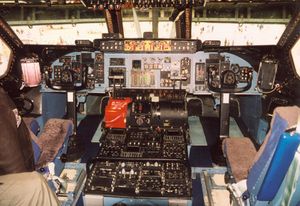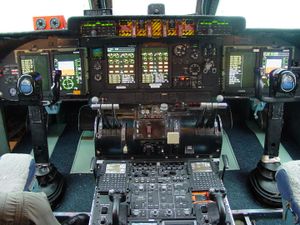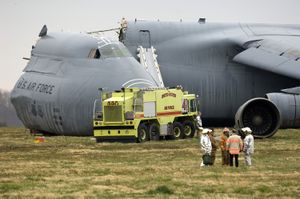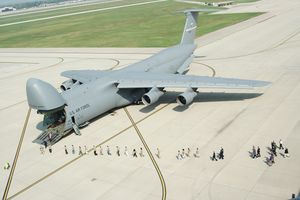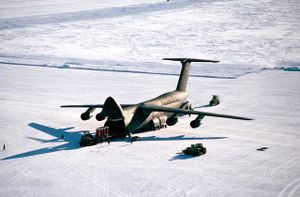PlaneSpottingWorld welcomes all new members! Please gives your ideas at the Terminal.
C-5 Galaxy
| C-5 Galaxy | |
|---|---|
| Type | Strategic airlifter |
| Manufacturer | Lockheed-Georgia Co. |
| Maiden flight | 30 June 1968 |
| Introduced | June 1970 |
| Status | Operational |
| Primary user | United States Air Force |
| Produced | C-5A: 1968-1973 C-5B: 1985-1989 |
| Number built | 131 (C-5A: 81, C-5B: 50) |
| Unit cost | US$167.7 million (C-5B) |
The Lockheed C-5 Galaxy is a military transport aircraft designed to provide strategic heavy airlift over intercontinental distances. It is the largest American military transport and one of the largest military aircraft in the world, designed to carry outsize and oversize cargo. The C-5 was developed and produced by Lockheed and is operated by the United States Air Force.
Contents
Mission
The C-5, with its tremendous payload capability, provides the Air Mobility Command (AMC) inter theater airlift in support of United States national defense. The C-5 and the C-17 Globemaster III are partners in AMC's strategic airlift concept. The aircraft can carry fully equipped combat-ready military units (including main battle tanks) to any point in the world on short notice, then provide the field support required to help sustain the fighting force.
History
In 1961, several aircraft companies began studying heavy jet transport designs that would replace the C-133 transport and complement current C-141 Starlifters. The US Army wanted a larger transport than the C-141. In 1962, the Army rejected the proposed CX-4 transport, because it was not viewed as a significant advance over the C-141. By late 1963, the CX-X conceptual design had a gross weight of 550,000 lb, a maximum payload of 180,000 lb and a speed of Mach 0.75. The cargo compartment was 17.2 ft wide by 13.5 ft high and 100 ft long with front and rear access doors.
Requests for Proposal (RFPs) for the Heavy Logistics System (CX-HLS) (previously CX-X) went for bid in 1964. The CX-HLS was equipped with four engines, instead of six engines in the earlier CX-4 concept. Later in 1964, proposals for aircraft were received from Boeing, Douglas, General Dynamics, Lockheed, and Martin Marietta. Proposals for engines were received from General Electric, Curtiss-Wright Corporation, and Pratt & Whitney. In 1965 Lockheed's aircraft design and General Electric's engine design were selected for the new transport.[1]
The first C-5A Galaxy (number 66-8303) was "rolled out" on March 2, 1968. On June 30, 1968 Lockheed-Georgia Co. began flight testing its new Galaxy C-5A heavy transport with the aircraft's first flight taking to the air under the call-sign "eight-three O three heavy".
Upon completion of testing the first C-5A was transferred to the Transitional Training Unit at Altus Air Force Base, OK, in December 1969. Lockheed then delivered the first operational Galaxy to the 437th Airlift Wing, Charleston Air Force Base, SC, in June 1970.
In the mid-1970s, wing cracks were found throughout the fleet. Consequently, all C-5A aircraft were restricted to a maximum of 50,000 lb (22,700 kg) of cargo each. To increase their lifting capability and service life, 77 C-5As underwent a re-winging program from 1981 to 1987. The final re-winged C-5A was delivered in July 1986.
The first C-5B incorporating significant improvements was delivered to Altus Air Force Base in January 1986. In April 1989, the last of 50 C-5B aircraft was added to the 77 C-5As in the Air Force's airlift force structure. The C-5B includes all C-5A improvements as well as more than 100 additional system modifications to improve reliability and maintainability. All C-5Bs are scheduled to remain in the active-duty force, shared by comparably sized and collocated Air Force Reserve associate units.
C-5s are stationed at Altus AFB, OK; Dover AFB, DE; and Travis AFB, CA. AMC transferred some C-5s to the Air Reserve components starting with Kelly AFB, Texas, in 1985; followed by Stewart Air National Guard Base, NY; and Westover Air Reserve Base, Massachusetts. Beginning in October 2005 squadrons were formed at Wright-Patterson Air Force Base near Dayton, Ohio, the Tennessee Air National Guard at Memphis International Airport, TN and Martinsburg WV (WV ANG) in December 2006. The Wright-Patterson C-5s replace the squadron's C-141s, which were the last Starlifters to be retired. In December of 2006, the 167th Airlift Wing of the West Virginia Air National Guard in Martinsburg (WV) received the first of 10 C-5A aircraft slated for the base. 70-0459 was the first Aircraft to go to Martinsburg. Memphis received 70-0449 as thier first aircraft in October 2003, while Wright Patterson received 70-0457 from Travis in October 05.
Dover AFB is the first base to have their fleet completed with the AMP. Dover will draw down the remaining legacy aircraft in mid 2007 to Westover ARB, MA. Dover will maintain 15 B models, and will gain 3 C-5M models sometime in early 2008. RERP production is slated to begin in May of 2008.
Retired aircraft
Fourteen C-5As have been retired. Aircraft number 69-0004 was the first, sent to the Warner-Robins ALC for tear down and inspection (data will be used to evaluate structural integrity and estimate remaining fleet lifespan). Thirteen C-5As were sent to AMARC for inspection, numbers 66-8304, 66-8305, 66-8306, 66-8307, 67-0167, 67-0168, 67-0169, 67-0170, 67-0171, 67-0173, 67-0174, 70-0450, and 70-0458. At AMARC, 66-8306 underwent tear down and inspection similar to 69-0004 at WR-ALC. The remaining 12 will eventually be reclaimed as destructive inspection is performed on the airframes to test for corrosion and fatigue.[1]
Features
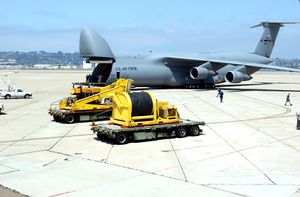
The C-5 is a large high-wing cargo aircraft. It has a distinctive high T-tail, 25 degree wing sweep, and four TF39 turbofan engines mounted on pylons beneath the wings. The C-5 is similar in appearance to its smaller sister transport, the C-141 Starlifter. The C-5 has 12 internal wing tanks and is equipped for aerial refueling. With aerial refueling, the Galaxy's range is limited only by crew endurance. It has both nose and aft doors for "drive-though" loading and unloading of cargo.
Features of the C-5 include:
- A cargo hold 121 ft long, 13.5 ft high, and 19 ft wide (37 m by 4.1 m by 5.8 m), or just over 31,000 ft3 (880 m³).
- An upper deck seating area for 73 passengers beyond the crew.
- Able to take off fully loaded within 8,300 ft (2,530 m) and land within 4,900 ft (1,490 m).
- Stall speed at maximum landing weight zero bank full flaps is approximately 114 knots (211 km/h).
- High flotation landing gear with 28 wheels sharing the weight.
- The nose and aft doors open the full width and height of the cargo compartment to permit faster and easier loading.
- A "kneeling" landing gear system that permits lowering of the parked aircraft so the cargo floor is at truck-bed height to facilitate vehicle loading and unloading.
- Full width drive-on ramps at each end for loading double rows of vehicles.
- MADAR, a system that records and analyzes information and detects malfunctions in more than 800 test points.
The Galaxy is capable of carrying nearly all of the Army's combat equipment, including bulky items such as the 74 ton armored vehicle launched bridge (AVLB), from the United States to any location on the globe.
Variants
C-5A
The C-5A is the original version of the C-5. From 1969 to 1973, 81 C-5As were delivered to US Air Forces bases. Due to cracks found in the wings in the mid-1970s, the cargo weight was restricted. To restore the plane's full capability, the wing structure was redesigned. A program to install new strengtened wings on 77 C-5As was conducted from 1981 to 1987. The redesigned wing made use of a new aluminum alloy that didn't exist during the original production.
C-5B
The C-5B is an improved version of the C-5A. It incorporated all modifications and improvements made to the C-5A with improved wings, upgraded TF-39-GE-1C turbofan engines and updated avionics. From 1986 to 1989, 50 of the new variant were delivered to the US Air Force.
C-5C
The C-5C is a specially modified variant for transporting large cargo. Two C-5s (68-0213 and 68-0216) were modified to have a larger internal cargo capacity, such as the removal of the troop compartment, to accommodate large payloads, such as satellites for use by NASA. A number of other modifications were made, including adding a second inlet for ground power which can then be used to feed any power-dependent equipment which may form part of the cargo. The two C-5Cs are operated by US Air Force crews on the behalf of NASA, and are stationed at Travis AFB, CA. 68-0216 completed the Avionics Modernization Program in January 2007.
C-5M
Based on a recent study showing 80% of the C-5 airframe service life remaining, AMC began an aggressive program to modernize all remaining C-5Bs and C-5Cs and many of the C-5As. The C-5 Avionics Modernization Program (AMP) began in 1998 and includes upgrading avionics to Global Air Traffic Management compliance, improving communications, new flat panel displays, improving navigation and safety equipment, and installing a new autopilot system. Another part of the plan is a comprehensive Reliability Enhancement and Re-engining Program (RERP), which includes new General Electric CF6-80C2 engines, pylons and auxiliary power units, with upgrades to aircraft skin and frame, landing gear, cockpit and the pressurization system. The CF6 engine produces 22% more thrust (for a total of 54,000 lb from each engine) than existing C-5 engines which will result in a 30% shorter take-off roll, a 38% higher climb rate to initial altitude, a significantly increased cargo load, and a longer range between refueling.[2] The C-5s that complete these upgrades are designated C-5M Super Galaxy.[3]
The C-5 modernization AMP and RERP programs plans to raise mission-capable rate to a minimum goal of 75%. Over the next 40 years, the U.S. Air Force estimates the C-5M will save over US$20 billion. The first of 111 planned C-5M conversions was completed on May 16, 2006, and performed its first flight on June 19.
Incidents and accidents
There have been four C-5 Galaxy crashes in the history of the plane along with two class-A losses resulting from ground fires and one loss resulting from damage sustained on the ground.
- Aircraft 67-0172 (C-5A) was destroyed during a ground fire at Palmdale, California on May 25 1970 after an ATM (Air Turbine Motor) started backwards and quickly overheated, setting the hydraulic system on fire and quickly consuming the aircraft. The engines were not running at the time of the fire and no one was injured.
- Aircraft 66-8303 (C-5A) was destroyed during a ground fire at Marietta, Georgia on October 17 1970. The fire started during maintenance in one of the aircraft's 12 huge fuel cells. One worker was killed and another injured. This was the first C-5 aircraft produced.
- Aircraft 66-8306 (C-5A) was badly damaged on September 29 1971 in Altus AFB, OK when the #1 engine and pylon broke loose and separated from the wing during the take-off roll.
- Aircraft 68-0227 (C-5A) was the first operational loss (crash) of a C-5 Galaxy. On September 27 1974 the aircraft crashed after over-running the runway at Clinton, Oklahoma Municipal Airport during an emergency landing following a serious landing gear fire. The crew mistakenly aligned the aircraft for the visual approach into the wrong airport, landing at Clinton Municipal which has a 4,400 ft (1340 m) runway, instead of Clinton-Sherman airfield which has a 13,500 ft (4115 m) runway.
- Aircraft 68-0218 (C-5A) was involved in the best known C-5 accident to this date. On April 4 1975, the aircraft crashed while carrying orphans out of Vietnam (Operation Baby Lift). The crash occurred while trying to make an emergency landing at Tan Son Nhut Air Base Saigon, following a door lock failure in flight. 144 adults and children (including 76 babies) were killed out of the 305 aboard (243 children, 44 escorts, 16 crewmen and 2 flight nurses).
- Aircrafts 70-0467 (C-5A) and 70-0466 (C-5A) were damaged in May 1982 when a tornado hit Altus (OK) AFB. The radome of 70-0467 was destroyed when it was struck by the right wingtip of the other C-5A. Both aircraft were repaired and returned to service. No injuries on the aircraft.
- Aircraft 68-0216 (C-5A) was badly damaged during a belly landing in 1985 at Travis AFB, CA. The crew had been performing touch-and-go approaches to the runway, and failed to extend the landing gear on final approach. The aircraft was rebuilt as a C-5C.
- Aircraft 68-0228 (C-5A) crashed following an engine failure shortly after take-off. On August 29 1990, the aircraft took off from Ramstein Air Base in Germany in support of Desert Shield. It was flown by a 9-member reserve crew (who had all volunteered to fly the mission) from the 68th Airlift Squadron, 433rd Airlift Wing based at Kelly AFB, Texas. As the aircraft started to climb off the runway, one of the thrust reversers suddenly deployed. This resulted in loss of control of the aircraft and the subsequent crash. Of the 17 people on board, only 4 survived the crash. All four were in the rear troop compartment. The sole crewman to survive, Staff Sgt Lorenzo Galvan Jr, was awarded the Airman's Medal for his actions in evacuating the survivors from the wreckage.
- Aircraft 70-0461 (C-5A) experienced a nose gear separation on August 16 2001 at Travis AFB, CA while attempting to take off. At the time of the incident the C-5A was assigned to the 436th Airlift Wing at Dover Air Force Base and was returning there from the Pacific theater.
- Aircraft 84-0059 (C-5B) crashed following an in-flight emergency again involving a thrust reverser (the in-flight deployment of which caused the loss of C-5A 68-0228). On April 3 2006 at 1045 UTC, the aircraft, assigned to the 436th Airlift Wing and flown by a reserve crew from the 326th Airlift Squadron, 512th Airlift Wing crashed about 2,000 ft short of RWY 32, while attempting a heavyweight emergency landing at Dover Air Force Base in Delaware. The airplane, carrying 17 people, had taken off from Dover about 21 minutes earlier and reported an in-flight emergency (number 2 engine thrust reverser not locked indication) 10 minutes into the flight. The crash occurred 11 minutes later. The aircraft broke into three sections and the #1 engine separated from the wing pylon with thousands of gallons of fuel spilled out, but, fortunately there was no fire and all 17 aboard survived with no life-threatening injuries. The Air Force's accident investigation concluded the crash was a result of human error, most notably the determination that the crew kept one of the functioning engines in flight idle while manipulating the throttle of the (dead) Number 2 engine as if it was still running.[4] The forward fuselage will be converted into a full-size C-5M cockpit simulator, and the rest of the airframe will be scrapped.[5]
Operators
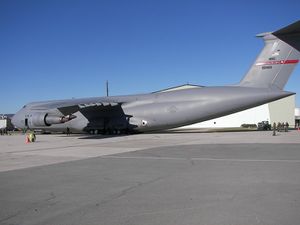
Unlike its Russian counterpart, the civilian- and military-operated Antonov An-124 'Condor' or An-225 "Mriya", use of the C-5 is confined entirely to the military sector.
- 60th Air Mobility Wing, Travis Air Force Base, California
- 97th Air Mobility Wing, Altus Air Force Base, Oklahoma
- 105th Airlift Wing (ANG), Stewart ANGB, New York
- 164th Airlift Wing, Memphis International Airport, Tennessee
- 167th Airlift Wing, Martinsburg, West Virginia
- 349th Air Mobility Wing, Travis Air Force Base, California
- 433d Airlift Wing, Lackland Air Force Base, Texas
- 436th Airlift Wing, Dover Air Force Base, Delaware
- 439th Airlift Wing, Westover Air Reserve Base, Massachusetts
- 445th Airlift Wing, Wright-Patterson Air Force Base, Ohio
- 512th Airlift Wing, Dover Air Force Base, Delaware
Specifications (C-5B)
Data from Quest for Performance[6]
General characteristics
- Crew: 8 typical (Pilot, first pilot, copilot, two flight engineers, three loadmasters)
4 minimum (Pilot, copilot, two flight engineers) - Payload: 270,000 lb (120,000 kg)
- Length: 247 ft 1 in (75.3 m)
- Wingspan: 222 ft 9 in (67.89 m)
- Height: 65 ft 1 in (19.84 m)
- Wing area: 6,200 ft² (580 m²)
- Empty weight: 380,000 lb (170,000 kg)
- Loaded weight: 769,000 lb (349,000 kg)
- Max takeoff weight: 840,000 lb (381,000 kg)
- Powerplant: 4× General Electric TF39 high-bypass turbofans, 43,000 lbf (190 kN) each
Performance
- Maximum speed: 500 knots (570 mph, 920 km/h)
- Range: 3,257 nm (3,749 mi, 6,033 km)
- Service ceiling: 34,000 ft (10.4 km)
- Rate of climb: 1,800 ft/min (9.1 m/s)
- Wing loading: 120 lb/ft² (610 kg/m²)
- Thrust/weight: 0.22
- Takeoff roll: 8,400 ft (2,600 m)
- Landing roll: 3,600 ft (1,100 m)
- Fuel capacity: 51,150 US gal (193,620 L)
Trivia
- The C-5's rudder area is the same as the wing area on the F-104G Starfighter.
- The paint alone weighs 2,600 pounds (1,200 kilograms).
- The C-5 contains more than 103 miles (165 km) of wire, 4 miles (6 km) of tubing, and 5 miles (8 km) of control cables.
- The C-5 is also known as "FRED" (Fucking Ridiculous Economic/Environmental Disaster) by its crews due to its propensity for (largely exaggerated) unreliability and massive consumption of fuel. Originated with high initial price tag and conspicuous major problems.
- Requires an average of 16 hours of maintenance for each flight hour.[citation needed]
- The plane was considered for the role of Shuttle Carrier Aircraft to transport the Space Shuttle to Kennedy Space Center by NASA, but rejected in favor of the Boeing 747 due in part to the 747's low-wing design. In contrast, the Soviet Union chose to transport its shuttles using the high-winged An-225, which is derived from the An-124, which is very similar to the C-5 in terms of design and function.
- The cargo compartment is long enough (143 feet, 9 inches) for the Wright brothers' first flight (120 feet) in 1903 to have taken place inside.
- The C-5 is the largest aircraft to ever operate in the Antarctic. Williams Field near McMurdo Station is capable of handling C-5 aircraft and the first C-5 landed there in 1989.[7]
Notes
- ↑ AMARC C-5 Galaxy article
- ↑ Saving the Galaxy
- ↑ "Second C-5M Super Galaxy takes flight." Air Force Print News. November 20, 2006.
- ↑ C-5 accident investigation board complete
- ↑ "Gone with the wings: C-5 removal process in full swing." Langley, N. Air Force News. January 19, 2007.
- ↑ Loftin, L. K., Jr.. Quest for performance: The evolution of modern aircraft. NASA SP-468. Retrieved on 2006-04-22.
- ↑ National Science Foundation (20 February 2002). Runway Project Clears the Way for Improved Antarctic Airlift. Press release. Retrieved on 2007-01-20.
External links
- C-5 Galaxy U.S. Air Force fact sheet
- "C-5 Galaxy". Pike, J. GlobalSecurity.org
- C-5 Galaxy U.S. Air Force history page
- "C-5 Galaxy" on Air-Attack.com
- "USAF banks on Lockheed Martin C-5M Super Galaxy as workhorse until 2040", Jane's International Defence Review, July 2006.
Related content
Comparable aircraft
Designation sequence
Related lists
See also
Airliners and Civil Transports: Vega · Electra · Electra Junior · Super Electra · Lodestar · Constellation · Saturn · L-188 Electra · L-402 · JetStar · L-1011 TriStar
Military Transports : C-64 · C-121 · R6V · C-130 Hercules · C-141 Starlifter · C-5 Galaxy
Fighters: F-22 Raptor · F-35 Lightning II · F-94 Starfire · F-104 Starfighter · F-117 Nighthawk · P-38 Lightning · P-80 Shooting Star · T-33 Shooting Star
Patrol and reconnaissance : Hudson · PV-1 Ventura · PV-2 Harpoon · P-2 Neptune · P-3 Orion · CP-140 Aurora/CP-140A Arcturus · U-2 · SR-71 Blackbird · S-3 Viking
Giant aircraft | |
|---|---|
| Production | |
| Prototypes | |
| Concepts | Proposed: Airbus A380-900 · Reaction Engines A2 · Beriev Be-2500 · Boeing 747-8 · Abandoned: Boeing New Large Airplane · Boeing Pelican · McDonnell Douglas MD-12 |
| Wingless aircraft | Biggest airship: Luftschiffbau Zeppelin Hindenburg class · Biggest blimp: Goodyear ZPG-3W · Biggest helicopter: Mil Mi-12 |
Lists relating to aviation | |
|---|---|
| General | Timeline of aviation · Aircraft · Aircraft manufacturers · Aircraft engines · Aircraft engine manufacturers · Airports · Airlines |
| Military | Air forces · Aircraft weapons · Missiles · Unmanned aerial vehicles (UAVs) · Experimental aircraft |
| Notable incidents and accidents | Military aviation · Airliners · General aviation · Famous aviation-related deaths |
| Records | Flight airspeed record · Flight distance record · Flight altitude record · Flight endurance record · Most produced aircraft |
bg:Ц-5 Галакси de:Lockheed C-5 es:C-5 Galaxy fr:Lockheed C-5 Galaxy it:Lockheed C-5 Galaxy he:C-5 גלקסי lt:Lockheed C-5 hu:C–5 Galaxy ms:C-5 Galaxy nl:Lockheed C-5 Galaxy ja:C-5 (輸送機) no:Lockheed C-5 Galaxy pl:Lockheed C-5 Galaxy pt:C-5 Galaxy ro:C-5 Galaxy sr:Локид Ц-5 fi:C-5 Galaxy sv:Lockheed C-5 Galaxy zh:C-5 th:ซี-5 กาแลคซี
